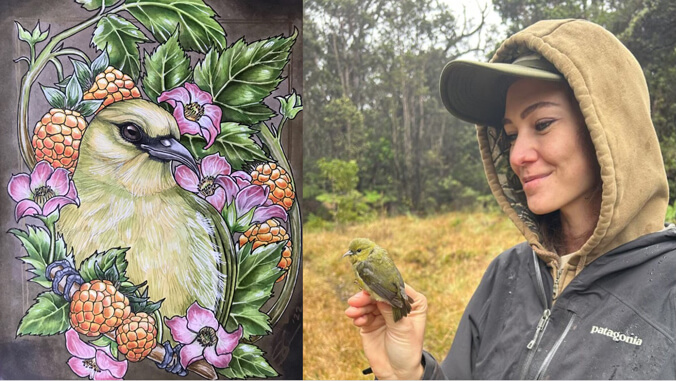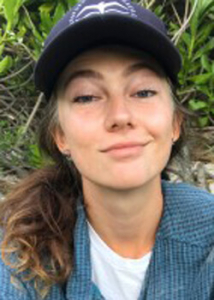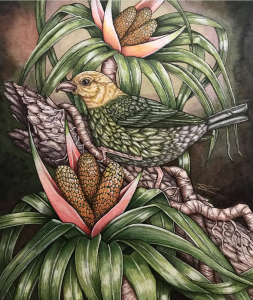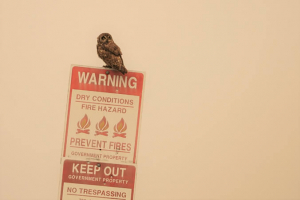
An environmental studies major and gifted artist, Saxony Charlot is passionate about raising awareness for Hawaiʻi’s endangered and threatened species. As she pursues her scientific studies at the University of Hawaiʻi at Hilo, her stunning artwork is flourishing.
“Hawaiian ecosystems are my passion,” she said. “It’s always just called to me. Since I was a kid, I’ve had a keen interest in Hawaiʻi’s native species and their conservation.”
This is reflected in two images of the week that she has contributed to UH News.
Family legacy

Charlot was born and raised on Oʻahu and grew up on a small family farm in Waimānalo to a family of artists. She is the great-granddaughter of Jean Charlot, a renowned muralist and painter, who also created murals for UH Mānoa and Leeward Theatre.
Both her great-grandfather and her grandfather, Martin, have been artistic inspirations for the young protégé throughout her life, and this background effortlessly melded with her love of conservation.
“I’ve been blessed to have had the opportunity to work and volunteer with numerous conservation projects on Oʻahu, Hawaiʻi Island, and in Papahānaumokuākea Marine National Monument,” she wrote in her web biography. “My field experience includes managing a native plant nursery, tagging Hawaiian monk seals, disentangling wild seabirds, surveying endangered honeycreepers, and more; I also have lab experience in micropropagation of rare plants and bioacoustics projects with native birds.”
The science
Currently, Charlot conducts research at the Listening Observatory for Hawaiian Ecosystems (LOHE) Lab, at UH Hilo, where the calls of native birds and other bioacoustics are analyzed using a variety of cutting-edge software.
One program she works with is BirdNET, a bioacoustics program developed by the Cornell Lab of Ornithology, which uses a neural network that can be trained to recognize bird calls. This helps conservation scientists in the wild by making the process of recognizing bird calls simpler and less time-consuming.
Charlot helps train the neural network by annotating native Hawaiian bird calls by hand using the bioacoustic software program Raven.
Patrick Hart, UH Hilo professor of biology and founder of LOHE Lab, said Charlot’s skills and patience as an artist make her exceptional at software work.
“Her work is contributing to the training of algorithms that will allow us to automatically detect these calls from future recordings,” Hart said.
The art

Precision and attention to detail aren’t the only things that Charlot’s lab work and art have in common. Her artwork primarily depicts native Hawaiian species, and her passion for species restoration and Hawaiian ecosystems greatly influences the subject matter. She works mainly with alcohol markers in pen and ink, but often uses acrylics, gel pens and color pencil for highlighting and detail.
One of her works, Ōu on ʻIeʻie, depicts the relationship between the now extinct native Hawaiian bird, the oʻu, and a native plant, the ʻieʻie, on which the oʻu fed. In 2022, the piece was featured in the prestigious Hawaiʻi Nei Art Exhibition, which is held annually at the Wailoa Center in Hilo and sponsored by several state and local conservation groups.
Charlot believes highlighting ecological relationships between species helps create a greater awareness of Hawaiian ecosystems and their diversity.
“A lot of our species are endangered, and a lot are extinct, and so people might not [know] about those kinds of relationships,” she said. “My goal is to raise awareness of Hawaiʻi’s ecology and native species, and I’d like to help people appreciate species that they won’t encounter day-to-day.”
Portions of the proceeds from art she sells go directly to conservation groups to help support species and ecosystem revitalization.
Charlot’s art is featured on her website Autochthonous Hawaiʻi and on her Instagram, where she posts the pictures along with a short write-up about each species.
The art of science

Charlot’s aspirations for the future are still mostly lab and fieldwork based, but she acknowledges that her art plays a large role in her conservation practice and her life.
“The art is kind of an aside that pulls it all together in my life,” she said.
“It’s funny, the art has made me realize that reaching people is really important in conservation work. For years I thought I just wanted to do things in the field, but, after doing fieldwork for so long, I realized that reaching other people in the community has maybe even a bigger impact.”
—By Evangeline Lemieux, who is double majoring in English and medical anthropology at UH Hilo

